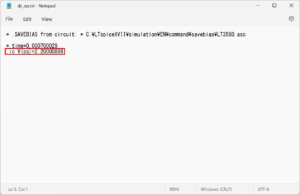.savebias : LTspice -- Save Operating Point to Disk
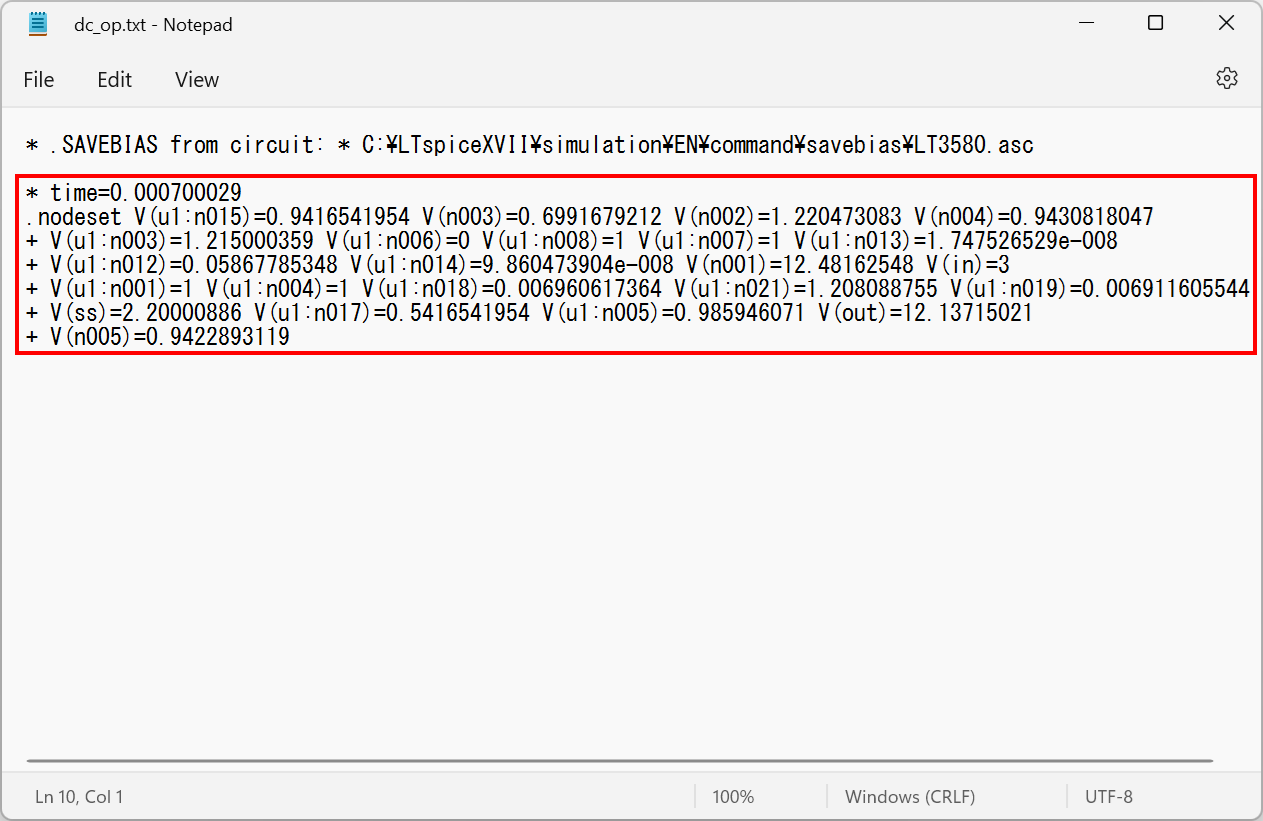
This article details the use of the dot command ".savebias".
It is possible to save the DC operating points to a file using ".savebias".
".savebias" syntax
The ".savebias" syntax is as follows. The DC operating points can be saved in a file.
Therefore, in the case of a simulation where convergence of the DC voltage operating points take time, the simulation time can be shortened by loading a file in which the DC voltage operating points are described by the command ".loadbias".
* <> parameters: not optional, [] parameters: optional
File Name
Enter the name of the file to be saved. We recommend "*.txt" for the extension, which is easy to edit later.
internal
Save the node voltage inside the device.
temp=Value
When simulating with a SPICE model with built-in temperature characteristics, save the DC operating points for a specific temperature.
For example, using the command ".temp" and entering ".temp -40 25 100" will set up a temperature analysis at temperatures of -40℃, 25℃, and 100℃.
Therefore, setting "temp=25" in the command ".savebias" will save the DC operating points when the temperature is ℃.
If "temp=value" is not set, the DC operating points of the last temperature entered with the command ".temp" will be saved, so in this example, the DC operating points when the temperature is 100°C will be saved.
(Even if the temperature does not correspond to the temperature set by the command ".temp", the DC operating points of the last temperature will be saved.)
For a detailed explanation of temperature analysis using the command ".temp", please refer to the following article.
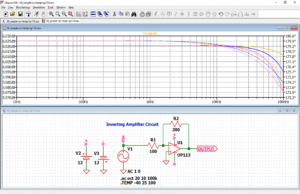
time=Value(* Transient Analysis Only)
In transient analysis (.tran), save the DC operating points for the time specified by "time=value".
For example, setting "time=1m" will save the DC operating points at the time "1msec".
For a detailed explanation of transient analysis (.tran), please refer to the following article.
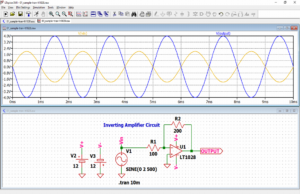
repeat
When "repeat" is set, the DC operating points are updated and saved at the time set by "time=value".
step=Value(* Parametric Analysis Only)
In parametric analysis (.step), save the DC operating points specified by "step=value".
For example, using the command ".step" and entering ".step param R1 100 200 300" will set the resistor R1 to change to 100Ω, 200Ω, or 300Ω.
Therefore, setting "step=0" in the command ".savebias" will save the DC operating points when resistor R1 is 100Ω.
If "step=value" is not set, the DC operating points of the last value entered with the command ".step" will be saved, so in this example, the DC operating points when resistor R1 is 300Ω will be saved.
For a detailed explanation of parametric analysis using the command ".step", please refer to the following article.
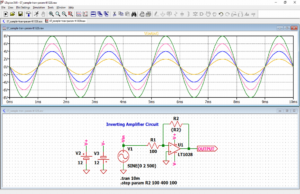
DC1=Value DC2=Value DC3=Value(* DC Sweep Analysis Only)
Saves the DC operating points specified by "DC1=value DC2=value DC3=value..." in DC sweep analysis (.dc). You do not necessarily need to specify more than one.
For example, using the command ".dc" and entering ".dc V1 0 5 1" will set up a DC sweep analysis by increasing the voltage source V1 by 1V from 0 to 5V.
Therefore, setting "DC1=2" in the command ".savebias" will save the DC operating points when the voltage source V1 is 2V.
Also, ".dc V1 0 5 1 I1 0 5 1" will increase the voltage source V1 from 0 to 5V by 1V and the current source I1 from 0 to 5A by 1A, so setting ".dc1=2 DC2=4" in the command ".savebias" will save the DC operating points when voltage source V1 is 2V and current source I1 is 4A.
For a detailed explanation of DC sweep analysis (.dc), please refer to the following article.
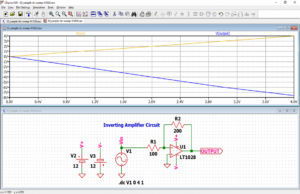
Examples of ".savebias" command
Three examples of ".savebias" commands are shown below:
.savebias DC_OP.txt time=0.7mSave the DC operating points at time "0.7msec" in the file "DC_OP.txt".
.savebias DC_OP.txt temp=25 time=0.7mSave the DC operating points at time "0.7msec" and temperature "25°C" in the file "DC_OP.txt".
.savebias DC_OP.txt time=0.7m step=0Save the DC operating points at time "0.7msec" and "the first value set by .step" in the file "DC_OP.txt".
If ".step param R1 100 200 300", then "R1=100Ω".
Examples of ".savebias" simulation
As an example of ".savebias" simulation, we would like to save the DC operating points in the LT3580 demonstration circuit of a boost/inverting DC-DC converter.
Click on the link below to go to the Analog Devices demo circuits download page.
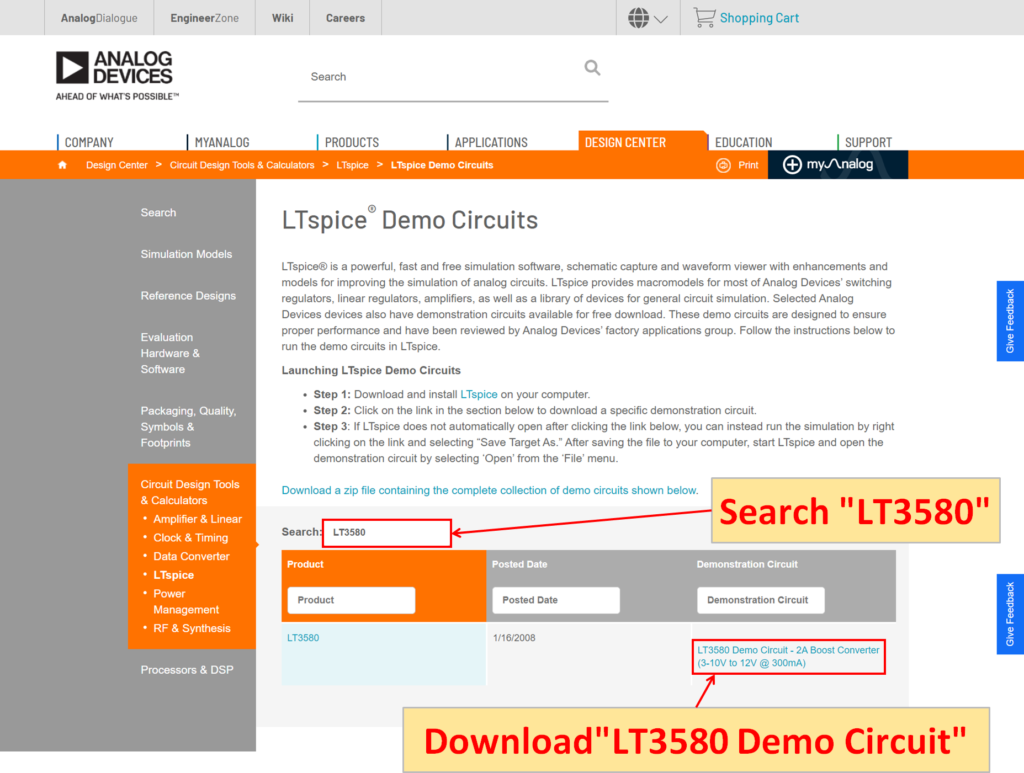
Enter "LT3580" in the "Search" field. A link to the LT3580 demo circuit will appear in the search results.
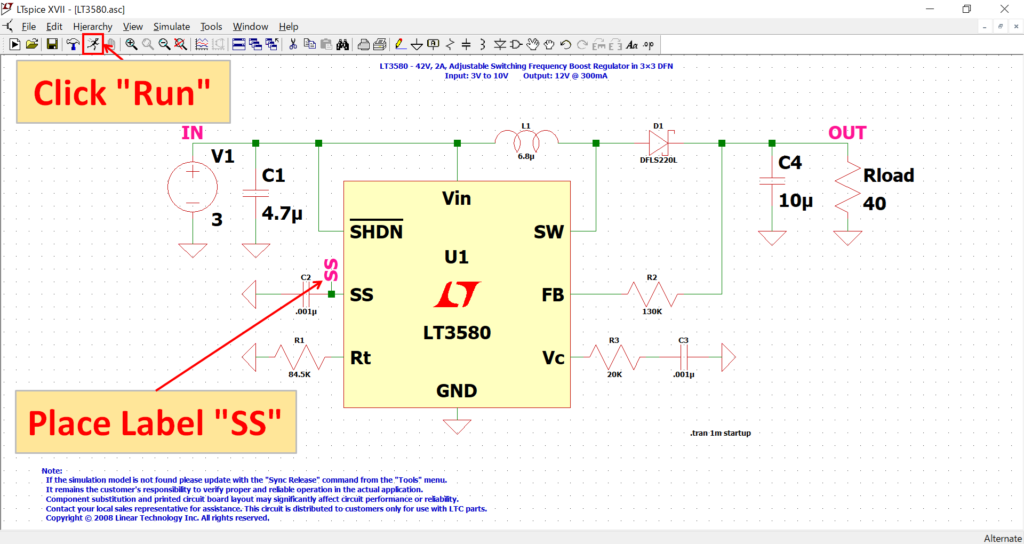
To make the waveform of the simulation results easier to distinguish, connect the "SS" label to the SS pin (soft start pin) of the LT3580 in advance.
After connecting the label, first run the simulation normally by clicking "Run" without ".savebias".
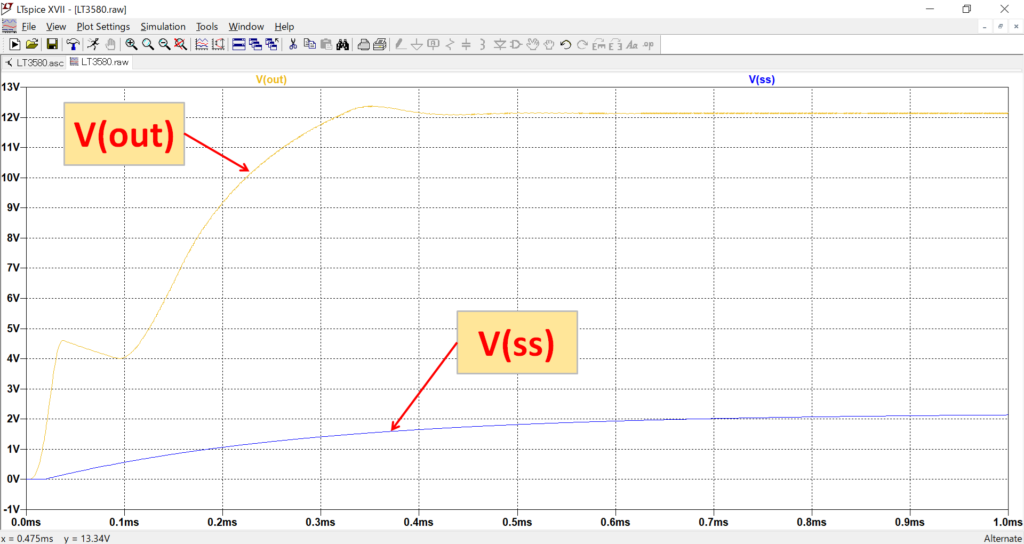
Click "out" and "ss" on the LT3580 schematic with a voltage probe to display the "V(out)" and "V(ss)" voltage waveforms in the waveform viewer.
You can see that the LT3580 is in a steady state with the SS pin voltage V(ss) charged to about 2V and the output voltage V(out) rising to 12V.
This time, we will try to save the DC operating points at "0.7ms" when this steady state is reached with the command ".savebias".
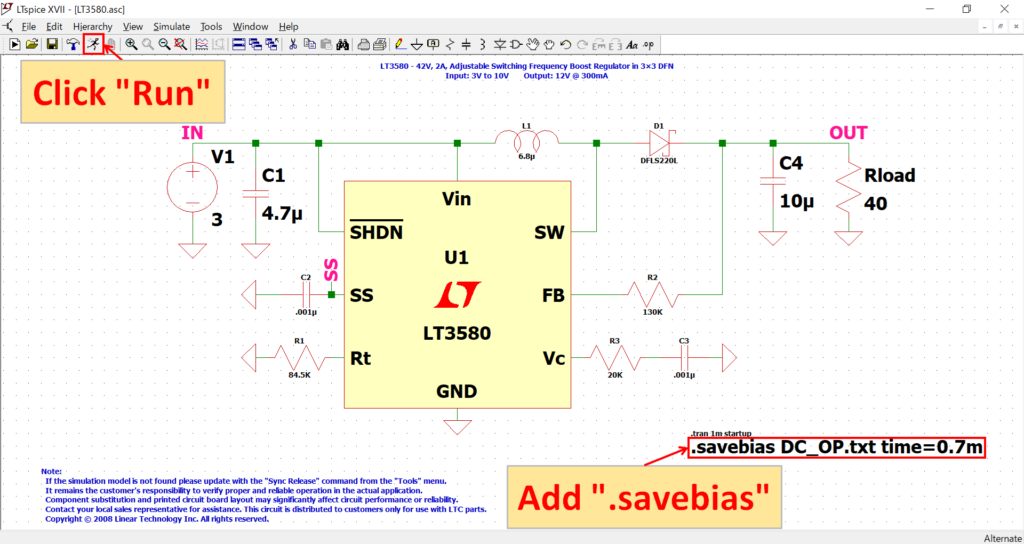
Add the ".savebias" syntax and click "Run" to run the simulation.
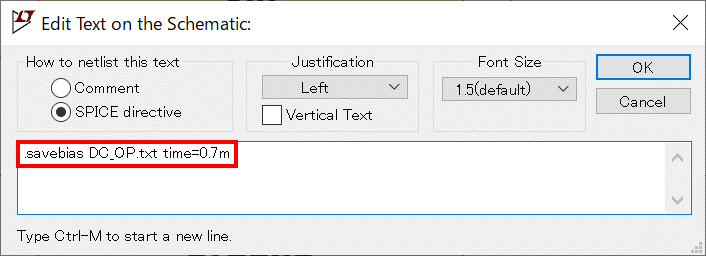
The ".savebias" syntax is described and placed as follows:
.savebias DC_OP.txt time=0.7mThis will save the DC operating points at time "0.7msec" in the file "DC_OP.txt".
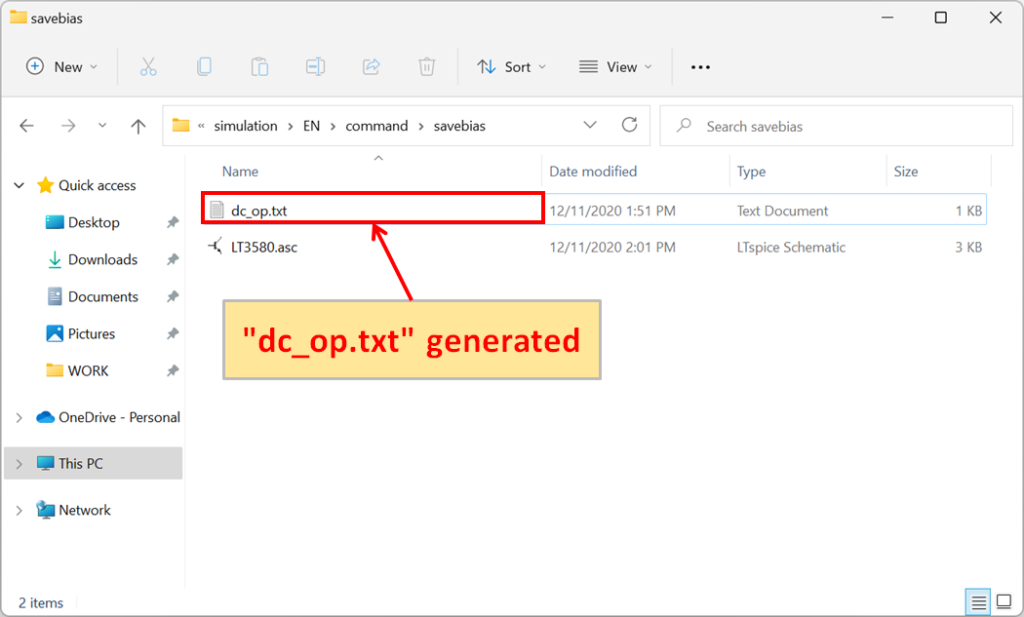
After the simulation is completed, check the same folder as the schematic file where the simulation was run, and you will find the file "DC_OP.txt" where the DC operating points are saved, so open it.
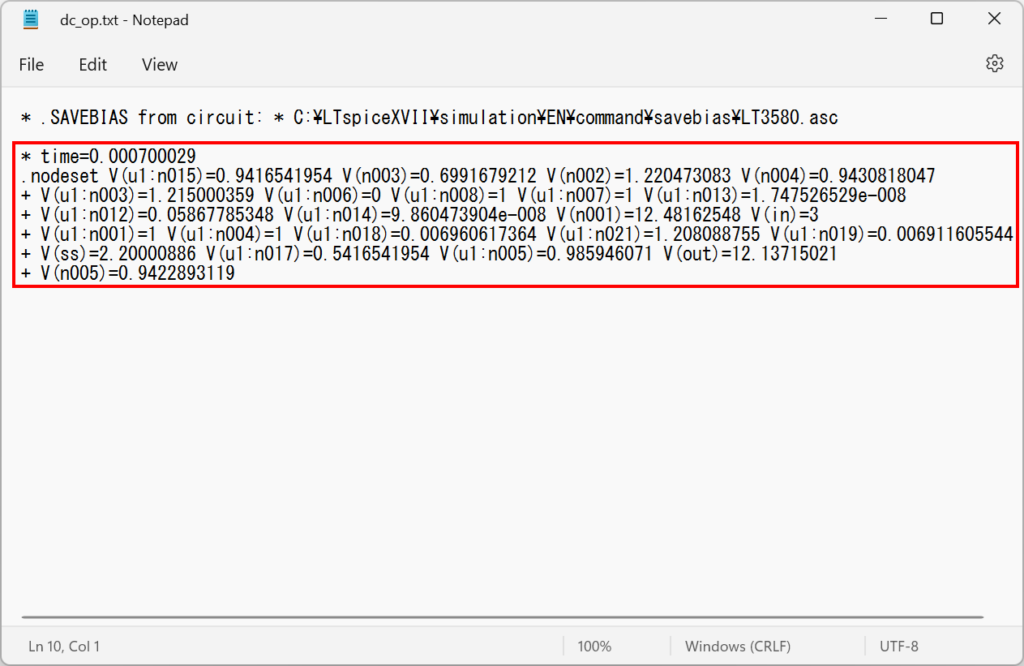
As shown above, you can see that the DC operating points of each node at "0.7msec" are saved.
How to use ".loadbias"
The DC operating points saved with the command ".savebias" can be loaded using the command ".loadbias".
For a detailed explanation of the command ".loadbias", please refer to the following article.
